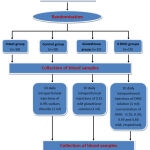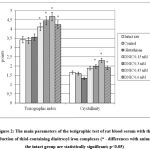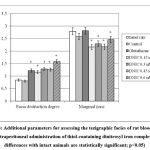Manuscript accepted on :10-03-2022
Published online on: 30-03-2022
Plagiarism Check: Yes
Reviewed by: Dr. Cherry Bansal
Second Review by: Dr. Salman Ahmed Pharmacognosy
Final Approval by: Dr. Ayush Dogra
Andrew K. Martusevich1-,3* , Lida K. Kovaleva5
, Lida K. Kovaleva5 , Konstantin A. Karuzin3
, Konstantin A. Karuzin3 , Alexandra V. Surovegina1-3
, Alexandra V. Surovegina1-3 , Mikhail Yu. Artamonov1
, Mikhail Yu. Artamonov1
1Laboratory of Translational Free Radical Biomedicine, Sechenov University, Moscow, Russia, 119991
2Laboratory of Medical Boiphysics, Privolzhsky Research Medical University, Nizhny Novgorod, Russia, 603005
3Bioniq Health-Tech Solutions Ltd., London, United Kingdom
4Department of Animal Physiology and Biochemistry, Nizhny Novgorod State Agricultural Academy, Nizhny Novgorod, Russia, 603117
5Department of Histology, Kuban State Medical University, Krasnodar, Russia, 350063
Corresponding Author E-mail: cryst-mart@yandex.ru
DOI : https://dx.doi.org/10.13005/bpj/2390
Abstract
The aim of the work was to study the effect of intraperitoneal administration of dinitrosyl iron complexes with glutathione ligands on the initiated crystallogenesis of rat blood serum. The experiment was performed on 70 male Wistar rats divided into 7 equal groups. The first group of animals was intact (without any manipulation). Rats included in the other groups were administered intraperitoneal injection of 1 ml. 0.9% sodium chloride solution daily for 10 days. At the same time, animals of the third to sixth groups were additionally added to the injected solution with dinitrosyl iron complexes with glutathione ligands (the concentration of the agent was 0.15; 0.30; 0.45 and 0.60 mM, respectively). The rats of the seventh group received 1 ml. an aqueous solution of glutathione (0.15 mM). The study of the effect of DNIC on the crystallogenic properties of rat blood serum was carried out by the method of comparative tezioraphy using a special system of criteria. The data obtained as a result of this study indicate the presence of modification of the crystallogenic (initiating) properties of rat blood serum during the course intraperitoneal administration of a physiological donor of nitric oxide to animals – DNIC, and this effect turns out to be dose-dependent and having an extremum in the region of 0.3-0.45 mM. Taking into account the fact that the crystallogenic properties are a reflection of the component composition and one of the physico-chemical parameters of the biological fluid, it can be assumed that the metabolic response of the body to the use of the compound is also dose-dependent. At the same time, relatively low doses of the agent have the most optimal effect on metabolic processes, stimulating the antioxidant potential of blood serum with a corresponding decrease in the intensity of lipid peroxidation processes, contributing to the optimization of energy metabolism and increasing the activity of detoxification enzyme systems. The results of the teziographic evaluation of animal blood serum samples after a course of injections of DNIC in various concentrations clearly indicate the activating effect of the compound with respect to the crystallogenic (initiating) properties of biological fluid, which is most pronounced when using the substance in 0.3- and 0.45-millimolar aqueous solutions.
Keywords
Blood Serum; Biocrystallomics; Crystallization; Dinitrosyl Iron Conplexes
Download this article as:| Copy the following to cite this article: Martusevich A. K, Kovaleva L. K, Karuzin K. A, Surovegina A. V, Artamonov M. Y. Influence of Physiological Donor of Nitric Oxide on Blood Serum Crystallostasis in Rats. Biomed Pharmacol J 2022;15(1). |
| Copy the following to cite this URL: Martusevich A. K, Kovaleva L. K, Karuzin K. A, Surovegina A. V, Artamonov M. Y. Influence of Physiological Donor of Nitric Oxide on Blood Serum Crystallostasis in Rats. Biomed Pharmacol J 2022;15(1). Available from: https://bit.ly/380xF9p |
Introduction
The discoverer of the physiologically deposited form of nitrogen monoxide, dinitrosyl iron complexes (DNIC), Prof. A.F. Vanin (2009) assumes the presence of numerous biological effects in it 1. DNIC were first identified as a form of nitric oxide in biological systems in the first EPR experiments that demonstrated the presence of NO in yeast cells 1, muscle cells and neurocytes 2. At the same time, the effect of this substance on biosystems has been actively studied only in recent decades 1, 3-5.
It should be noted that DNICs are able to interact effectively with various substances that become their ligands 6, 7. The most common ligands are thiol-containing compounds, in particular, glutathione or cysteine 1, 8. Ligands determine the features of additional effects of DNIC, determining the two-component nature of their activity, associated not only with the possibility of gradual or bolus release of nitric oxide, but also with the properties of functional groups of ligands 1, 3, 6.
Previously, bioregulatory properties were described for the compound in question, but the focus of these studies has shifted towards in vitro studies with isolated systems 6, 7, 9, 10. It should be noted that to a greater extent these studies concern the disclosure of the features of the influence of DNIC on the state of pro- and antioxidant systems in a variety of biological and abiogenic systems.
Over the past few decades, a number of russian and foreign authors have shown the informativeness of the study of the crystallogenic activity of human biological fluids as an alternative method of integral assessment of physical and chemical properties 11, 12. It should be noted that this thesis fully concerns the biological environment of animals 13. Based on this, the aim of the work was to study the effect of intraperitoneal administration of dinitrosyl iron complexes with glutathione ligands on the initiated crystallogenesis of rat blood serum.
Material and methods
Animals and exposures
The experiment was performed on 70 male Wistar rats divided into 7 equal groups. The first group of animals was intact (without any manipulation). Rats included in the other groups were administered intraperitoneal injection of 1 ml. 0.9% sodium chloride solution daily for 10 days. At the same time, animals of the third to sixth groups were additionally added to the injected solution with dinitrosyl iron complexes with glutathione ligands (the concentration of the agent was 0.15; 0.30; 0.45 and 0.60 mM, respectively). The rats of the seventh group received 1 ml. an aqueous solution of glutathione (0.15 mM). In animals of all groups, blood samples were obtained. We collected blood samples in rats of the first (intact) group once, and in animals of the other groups – twice (before and immediately after the end of the course of exposure). Study design presented in figure 1.
 |
Figure 1: Study design |
Dinitrosyl iron complexes with glutathione ligands (DNIC) were synthesized by the method of A.F. Vanin [8, 14]. The concentration of the compound in the saline solution, determined spectrophotometrically by known extinction at wavelengths of 310 and 360 nm, was 3.1 mmol/L.
The study was approved by Local Ethic Committee of Privolzhsky Research Medical University (no. 3/18 from 05/02/2018).
Crystalliscopic study
The study of the effect of DNIC on the crystallogenic properties of rat blood serum was carried out by the method of comparative tezioraphy using a special system of criteria [15, 16]. The main indicators evaluated on a point scale were the teziographic index (reflects the ratio of the number of crystalline elements in facies formed by a mixture of biofluid and basic substance, as well as the latter in an individual form), crystallinity (characterizes the complexity of the structural construction of elements), the facia destruction degree (is an indicator of the correctness of the formation of structures) and the clearity of the marginal zone of the micropreparation. 0.9% sodium chloride solution was used as the base substance.
Statistics
The results were processed using the Statistica 6.0 program. All the data were processed with standard algorithms of descriptive statistics and were present as Mean±SD. The Student’s t-test was used for detection of statistical differences.
Results
It was found that according to the main quantitative parameter of the description of the result of the tezigraphic test – the teziographic index – differences are observed in all NO-stimulation modes used (Fig. 2).
Thus, for animals of the intact and control groups, the values of the indicator were within 3.5 points, which indicates as much as possible only a two-fold initiatory potential of the biological medium (the number of structural elements in the co-crystallized sample is no more than 2 times higher than their number in the control sample of the basic substance). On the contrary, with the introduction of DNIC, a pronounced increase in the value of the teziographic index was observed, indicating a significant increase in the initiatory potential of the biological fluid of rats of these groups (p<0.05 for all cases). The most significant deviations were recorded when using DNIC at a concentration of 0.45 mM. It should be noted that in animals receiving injections of glutathione, which acts as a ligand in the composition of the studied variant of DNIC, there was no significant shift in the teziographic index relative to both intact and control group rats.
The crystallinity of the tezigrams, which characterizes the complexity of the construction of elements and is similar in its essence to the structural index of the crystallogram, fully confirmed the tendencies to activate initiated crystallogenesis, detected by the teziographic index, in animals receiving injections of DNIC (Fig. 2). The extremum of this parabolic dependence, corresponding to a concentration of 0.45 mM, was similar. It should be emphasized that with all the doses of the compound used, statistically significant deviations from the level recorded for both intact and control group rats were noted in terms of crystallinity (p<0.05 for both cases). Interestingly, the use of glutathione alone demonstrated the reverse effect of DNIC, manifested in a moderate tendency to decrease the proportion of dendritic elements in the facias (p<0.1 compared with non-injected and injected with saline solution animals).
A general trend towards the introduction of DNIC was also observed with respect to the parameter characterizing the correctness of the structure of the elements of the micropreparation – the facia destruction degree (Fig. 3), and differences were observed at all studied concentrations of the compound (p<0.05). At the same time, relatively “low” and “medium” doses of the agent caused a comparable shift in the indicator (an increase of 138-150% to the level characteristic of rats of the intact group; p<0.05) It should be noted that intraperitoneal use of glutathione solution has a comparable effect on the facia destruction degree (an increase of 45%; p<0.05), which indicates the nonspecific nature of these shifts. The most significant variations in the facia destruction degree were recorded when the animals were injected with DNIC at a concentration of 0.6 mM, which manifested itself in its increase by 1.88 times (p<0.05 compared to rats of the intact group), which may indirectly indicate a suboptimal reaction to this dose of the compound.
We also analyzed the clearity of the marginal zone of blood serum samples of rats of the formed groups (Fig. 3). This parameter characterizing the protein component of the biological fluid in the native state in the representatives of the control group did not differ from the physiological level represented by intact animals. Intraperitoneal administration of an aqueous solution of glutathione also did not cause changes in the size of the marginal zone of micropreparations of dried biological fluid. On the contrary, in all rats receiving injections of a nitric oxide donor, a moderate decrease in this parameter was observed (by 5-15% relative to the values calculated for intact animals), which potentially indicated minor conformational modifications of proteins under the influence of the studied effect and could be due to the change of glutathione ligands of DNIC to protein ligands.
Discussion
The data obtained as a result of this study indicate the presence of modification of the crystallogenic (initiating) properties of rat blood serum during the course intraperitoneal administration of a physiological donor of nitric oxide to animals – DNIC, and this effect turns out to be dose-dependent and having an extremum in the region of 0.3-0.45 mM. Taking into account the fact that the crystallogenic properties are a reflection of the component composition and one of the physico-chemical parameters of the biological fluid 12, 13, 15, 16, it can be assumed that the metabolic response of the body to the use of the compound is also dose-dependent. At the same time, relatively low doses of the agent have the most optimal effect on metabolic processes, stimulating the antioxidant potential of blood serum with a corresponding decrease in the intensity of lipid peroxidation processes, contributing to the optimization of energy metabolism and increasing the activity of detoxification enzyme systems. This has been shown by us in vitro experiments 17-20, as well as on the model of severe thermal injury 3, consistent with the data of other authors on the positive metabolic effect of DNC 1, 6, 9, 14. In addition, results comparable to those presented in the article on the peculiarities of metabolic modification were obtained in relation to healthy rats.
Conclusion
Thus, the results of the teziographic evaluation of animal blood serum samples after a course of injections of DNIC in various concentrations clearly indicate the activating effect of the compound with respect to the crystallogenic (initiating) properties of biological fluid, which is most pronounced when using the substance in 0.3- and 0.45-millimolar aqueous solutions.
Acknowledgment
This study was funded by Ministry of Health of Russian Federation.
Conflict of Interests
The authors declare that they have no competing interests.
Funding Sources
There is no funding Source.
References
- Vanin AF. Dinitrosyl-iron complexes with thiolate ligands: physico-chemistry, biochemistry and physiology. Nitric Oxide Biol. Chem. 2009;21:136-49.
CrossRef - Murad F. The role of nitric oxide in modulating guanylyl cyclase. Neurotransmission. 1994;10:1-4.
- Martusevich AK, Solovieva AG, Peretyagin SP, Davydyuk AV. The effect of dinitrosyl iron complexes on the metabolic parameters of the blood of animals with experimental thermal trauma. Biophysics. 2014;59(6):1173-9.
CrossRef - Timoshin AA et al. Assessment of the level of nitric oxide in rat organ tissues and its change during prolonged inhalation of air with an increased content of nitric oxide. Reports of the Russian Academy of Sciences. 2009;425:110-3.
CrossRef - Hall CN, Garthwaite J. What is the real physiological NO concentration in vivo? Nitric Oxide Biol. Chem. 2009;12(2):92-103.
CrossRef - Shumaev KB, Gubkin AA, Gubkina SA et al. Interaction of dinitrosyl iron complexes with intermediates of oxidative stress. Biophysics. 2006;51(3):472-7.
CrossRef - Shumaev KB, Petrova NE, Zabbarova IV et al. Interaction of oxoferrylmyoglobin and dinitrosyl iron complexes. Biochemistry. 2004;69(5):699-705.
CrossRef - Borodulin RR, Kubrina LN, Shvydkiy VO et al. A simple protocol for the synthesis of dinitrosyl iron complexes with glutathione: EPR, optical, chromatographic and biological characterization of reaction products. Nitric oxide. 2013;35:110-5.
CrossRef - Giliano NY et al. Dinitrosyl-iron complexes with thiol-containing ligands and apoptosis: studies with HeLa cells. Nitric Oxide Biol. Chem. 2011;24:151-9.
CrossRef - Nitric Oxide. Basic Research and Clinical Application / Ed. R.J. Gryglewsky, P. Minuz. Amsterdam; Berlin; Oxford; Tokyo; Washington: IOS Press, DC, 2001.
- Denisov AB. Algorithm for evaluating crystal figures obtained by drying mixed saliva. Bulletin of Experimental Biology and Medicine. 2004;136(7):37-40.
CrossRef - Kidalov VN, Khadartsev AA, Yakushina GN. Thesiographic blood tests and their practical possibilities. Bulletin of New Medical Technologies. 2004;11(1-2):23-5.
- Gromova IP. A crystalloscopic method for studying blood serum in a toxicological and hygienic experiment by the “open drop” method. Hygiene and sanitation. 2005;2:66-69.
- Vanin AF, Chazov EI. Prospects of desingning medicines with diverse therapeutic activity on the basis of dinitrosyl iron complexes with thiol-containing ligands. Biophysics. 2011;56(2):268-75.
CrossRef - Kamakin NF, Martusevich AK. Modern approaches to the crystalloscopic identification of the composition of biological fluids. Human ecology. 2003;5:23-5.
- Martusevich AK. Biocrystallomics in molecular medicine. St. Petersburg: Publishing house SPbSMU; Tver: LLC “Publishing House “Triada”; 2011. 112 p.
- Vanin AF, Martusevich AK, Peretyagin SP, Davydyuk AV. Evaluation of the effect of dinitrosyl iron complexes on some physical and chemical parameters of blood in vitro. Medical almanac. 2013;3:37-38.
- Martusevich AK, Solovieva AG, Peretyagin SP. Influence of free and deposited nitric oxide on blood energy metabolism. Modern technologies in medicine. 2013;5(4):33-38.
- Martusevich AK, Solovieva AG, Peretyagin SP. The influence of various forms of nitric oxide on the properties of aldehyde dehydrogenase of erythrocytes. Questions of biological, medical and pharmaceutical chemistry. 2014;11:60-65.
- Martusevich AK, Solovieva AG, Peretyagin SP, Vanin AF. Comparative analysis of the effect of free and deposited NO on the state of pro- and antioxidant blood systems. Biophysics. 2015;60(2):348-354.
CrossRef









